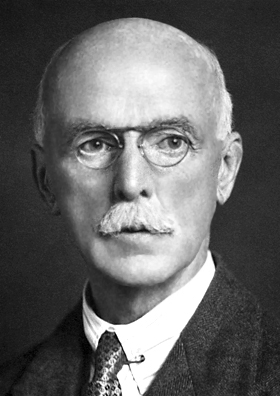Arthur Harden facts for kids
Quick facts for kids
Sir Arthur Harden
FRS
|
|
|---|---|
 |
|
| Born | 12 October 1865 |
| Died | 17 June 1940 (aged 74) Bourne End, Buckinghamshire, England, UK
|
| Alma mater | University of Manchester MSc, University of Erlangen PhD |
| Known for | the chemistry of the yeast cell |
| Spouse(s) | Georgina Sydney Bridge |
| Awards | Nobel Prize in Chemistry (1929) Davy Medal (1935) |
| Scientific career | |
| Fields | Biochemistry |
| Institutions | Lister Institute |
| Doctoral advisor | Otto Fischer |
| Doctoral students | Roland Victor Norris Ida Maclean |
Sir Arthur Harden (born October 12, 1865 – died June 17, 1940) was a famous British biochemist. He studied the amazing ways living things use chemistry. In 1929, he won the Nobel Prize in Chemistry. He shared this big award with Hans Karl August Simon von Euler-Chelpin. They won for their important work on how sugar turns into alcohol, a process called fermentation. This process uses special helpers called enzymes.
Arthur Harden was also a founding member of the Biochemical Society. He was the editor of their science journal for 25 years.
Contents
Biography
Early Life and Education
Arthur Harden was born in Manchester, England. His father, Albert Tyas Harden, was a Scottish businessman. Arthur went to a private school first. Later, he studied at Tettenhall College in Staffordshire.
In 1882, he started studying at Owens College. This college is now known as the University of Manchester. He graduated in 1885. He learned chemistry from Professor Roscoe there.
Starting His Research Career
In 1886, Arthur Harden won a special scholarship for chemistry. He used it to work with Otto Fischer in Erlangen, Germany, for a year. There, he studied how to make and understand a chemical called β-nitroso-α-naphthylamine.
After earning his PhD, he came back to Manchester. He became a teacher and demonstrator. During this time, he also studied the life and work of a famous scientist, John Dalton. In 1895, he co-wrote a textbook about Practical Organic Chemistry.
Work at the Lister Institute
In 1897, Arthur Harden moved to a new job. He became a chemist at the British Institute of Preventive Medicine. This institute later became known as the Lister Institute. He earned another degree, a Doctor of Science (D.Sc.), in 1902.
In 1907, he became the head of the Biochemical Department. He kept this important job until he retired in 1930. Even after retiring, he continued his scientific work at the Institute.
Key Discoveries and Awards
At the Lister Institute, Harden studied how light affects gases. He then used these ideas to study living things. He looked at how bacteria cause chemical changes. He also studied how glucose (a type of sugar) breaks down.
His most famous work was on the chemistry of yeast cells. Yeast is used to make bread and alcohol. He also wrote papers about important vitamins, like those that prevent scurvy.
Arthur Harden was recognized for his amazing work. He was made a knight in 1926, so his title became "Sir Arthur Harden." He also received many honorary doctorates. He was a member of the Royal Society. In 1935, he received the Davy Medal, another big award for scientists.
The "Harden–Young Ester"
Sir Arthur Harden worked with another scientist, William John Young. They studied how sugar breaks down in yeast. This process is called glycolysis. They found a new chemical compound.
They first called it the Harden–Young ester. Later, scientists found out it was actually fructose 1,6-bisphosphate. This chemical is made when another sugar, fructose 6-phosphate, is changed by an enzyme. Then, it breaks down into two smaller parts.
Personal Life
Arthur Harden married Georgina Sydney Bridge in 1900. She passed away in January 1928. They did not have any children.
See also
 In Spanish: Arthur Harden para niños
In Spanish: Arthur Harden para niños
- William John Young

